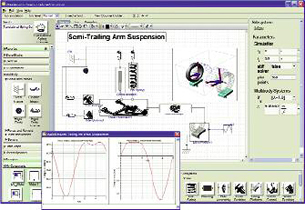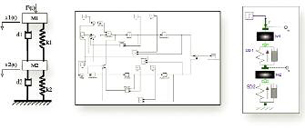September 1, 2008
By Laurent Bernardin
 MapleSimis an example of a new generation modeling tool using Modelica. |
Physics-based modeling — or physical modeling — for virtual prototyping of engineering products has brought about dramatic savings in time and cost over the last 20 years. Furthermore, the increasing use of controllers in engineering products has driven the use of physical modeling tools for accurate plant characterization, which is usually the first and often the most time-consuming stage in control system development.
Accurate prediction of the behavior of engineering systems, through the use of powerful mathematical modeling tools, can save millions of dollars in the prototyping and production stages of product development. This has motivated many engineering organizations to invest heavily in model-based design and simulation tools.
However, it is becoming apparent that existing modeling tools fall short of what is required to do this effectively, and physical modeling of engineering systems has become a hot topic among engineers as they reach these limits. Fortunately, a new wave of methodologies, technologies, and products is emerging to address the issues faced by engineers, and one particular European initiative is leading the movement.
 Modelica allows use of an object-oriented representation that permits a very easy definition of asystem model by graphically describing its topology. Above is a causal vs. acausal representation. |
Modelica Eases Development
But first, a look at the limitations in current practices is in order. If you consider the history of engineering modeling and simulation, you will note that the block-diagram approach has changed very little in more than 50 years. The signal-flow paradigm it uses is a legacy from the days of the analog computer.
As pressures grow on their time, engineers are now finding this approach to physical modeling to be onerous because of the time and effort required to manually prepare the model for representation as a block diagram. The approach is also inherently weak in certain computational respects, such as poor handling of algebraic loops.
To address these issues, a new approach to physical modeling is emerging from a collaboration between several European universities, tool vendors, and industrial partners. The Modelica Association was started in 1996 as an initiative to develop a standard model-definition language that would allow convenient, component-oriented modeling of complex engineering systems that require the inclusion of multiple domains such as mechanical, electrical, electronic, hydraulic, thermal, control, electric power, or process-oriented subcomponents. Modelica models capture and manage all of the necessary relational, physics, and mathematical information for complex systems. Because it is better suited for handling the mathematical framework of model development, Modelica makes detailed models easier to develop.
Differential Algebraic Equations
The Modelica language allows use of an object-oriented representation that permits a very easy definition of a system model by graphically describing its topology; simply put, users connect components and define how they are related without having to worry about which signals are inputs and which are outputs. This means, for example, that an electric circuit (a classic example of a topological representation) looks like an electric circuit on a computer screen: this circuit can then be easily connected to a mechanical system model through motor models, shafts, gears, and so on.
This topological approach to model definition is called “acausal” and lifts many of the restrictions imposed by the signal-flow, or “causal,” approach. This has made the mathematical formulation of system models very easy, but has led to some challenges in running simulations. Causal block-diagram tools only need to solve systems of ordinary differential equations (ODEs), but acausal modeling introduces a different class of mathematical model, differential algebraic equations (DAEs). These are systems that include both ODEs and algebraic equations that are introduced by added physical constraints. Depending on the nature of these constraints, the DAE problem increases in complexity, usually indicated by an increase in the DAE “index.”
The development of generalized solvers for high-index DAEs is the subject of a great deal of research, and it is acknowledged by leaders in the field that symbolic computation will play a major role. Maplesoft has been actively engaged in developing DAE solvers that incorporate leading-edge symbolic and numeric techniques for solving high-index DAEs for many years. These solvers have been incorporated in Maple, an advanced environment for mathematical modeling and technical computing.
Until now, the use of Modelica has been largely focused within European companies that were early to adopt this new modeling methodology, and it is beginning to impact mainstream engineering there. However, word is spreading in North America: there is a growing move toward offering modeling tools that use the topological modeling approach, described earlier, for multi-domain systems.
An Open Process
Maplesoft offers a new generation of model-development and simulation products that harness the Modelica language. MapleSim, one such product, is a high-performance multi-domain modeling and simulation tool designed to revolutionize how products are brought to market and shorten the product development cycle. It enables designers to easily build and understand systems with compact and intuitive component diagrams, and automatically generate and simplify model equations.
One of the early proponents of Modelica is Dr. Michael Tiller, VP of modeling R&D with the Michigan-based engineering consulting firm Emmeskay, Inc., and author of the book Introduction to Physical Modeling with Modelica.
“Modelica was started as an effort to develop a non-proprietary approach to modeling,” says Tiller. “The goal was to make modeling an open process, allowing free collaboration between industry, universities, and tool vendors. As the growth of the Internet has shown, open standards are much better for consumers than so-called ‘walled gardens,’ and I am excited to see Maplesoft embracing Modelica.”
With the help of Modelica, Maplesoft is addressing many of the weaknesses inherent in traditional modeling tools, as well as the challenges of advanced approaches, to feed into the next generation of modeling and simulation tools.
More Info:
Emmeskay, Inc.
Plymouth,MI
emmeskay.com
Maplesoft
Waterloo, ONT
maplesoft.com
Modelica
Bielefeld,Germany
modelica.org
Laurent Bernardin is vice-president of R&D and chief scientist at Maplesoft. He is responsible for the corporate technology vision of Maplesoft as well as its product development. Send e-mail about this article to [email protected].
Subscribe to our FREE magazine, FREE email newsletters or both!
About the Author
DE’s editors contribute news and new product announcements to Digital Engineering.
Press releases may be sent to them via [email protected].






